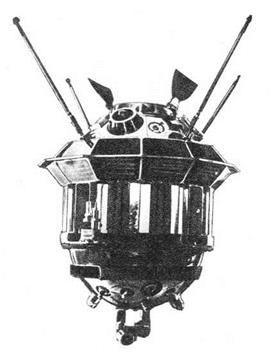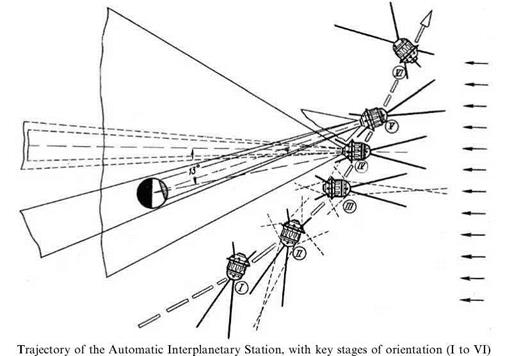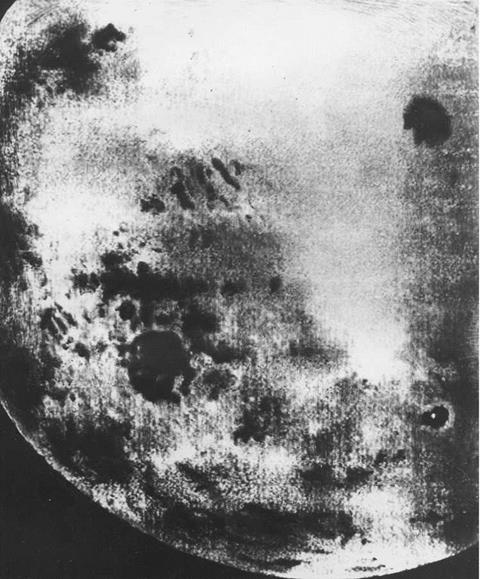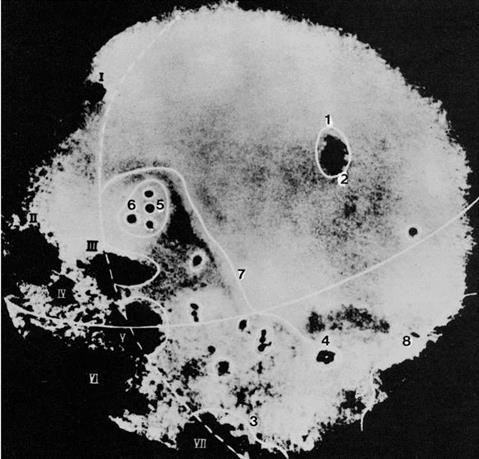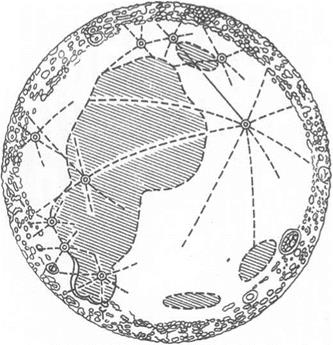THE AUTOMATIC INTERPLANETARY STATION
The early frustrations of 1958 could be put to one side now: the knifelike precision of the Second Cosmic Ship showed what could be done. The accuracy of the Second Cosmic Ship was not lost on the Americans, who had never attained such early accuracy. Not that they were given much time to recover. Three weeks later, and on the second anniversary of Sputnik, a third cosmic ship lifted off the pad.
This was the first Ye-2 type of moon probe (though, to be completely accurate, it had now been designated Ye-2a). There was quite a jump between the Ye-1 type of probe and the ambition of a Ye-2 or Ye-3. Both required great accuracy, but the farside photography mission especially so. For lunar imaging, Keldysh’s Mathematical Institute was called in. Such a mission must take place when the farside was lit up by the sun and bring the probe on a trajectory back to the Earth high over the Soviet Union so that it could transmit back the pictures. Such optimum conditions would take place infrequently: in October 1959 (photography after approaching the moon) and April I960 (photography while approaching the moon). The spacecraft would require an orientation system to make sure the cameras pointed the right way and that the transmissions were subsequently relayed back to the Earth. The orientation system was developed by Boris Raushenbakh and a team of seven young engineers who built the parts from shop-bought electronic components, the Soviet Radio Shack of its day. Boris Raushenbakh (1915-2001) was, as his name suggests, German by background and for this reason was interned during the war. In his spare time, he developed an expertise in the history of Russian art. He was allowed to return to the Keldysh Research Centre after the war, where he developed a knowledge of spacecraft orientation. Gas jets provided the all-important orientation system. Sensors were used to maintain orientation toward the Earth, sun and moon. The station was the first spacecraft to develop a three-axis stabilization system. For
|
The Automatic Interplanetary Station |
the flyby, the sensors would be used to locate the sun, Earth and moon and once this was done, the spacecraft’s thrusters would fire until it was brought into the desired position for photography or communications or whatever was required. His system has been used ever since.
Two camera systems were developed, the successful one being built by Television Scientific Research Institute NII-380 in Leningrad under Petr Bratslavets (1925— 1999), assisted by I. A. Rosselevich. To take pictures, the Russians opted not for relatively new television systems like the Americans but for older, mechanical designs likely to give much higher quality. The imaging system was called Yenisey 2 and this comprised a duel-lens camera, scanner and processing unit. The dual lens could take up to 40 pictures at 200 mm, f5.6 (designed for the full moon) or 500 mm, f9.5, designed for close-ups. The cameras could not be moved or swivelled: instead, the spacecraft itself would be rotated to point in the appropriate direction. Transmissions of signals could be made at two speeds: slow, at 1.25 lines a second (for distant transmissions) and faster, at 50 lines a second (closer to Earth).
The photographs would be developed onboard and then scanned by a television camera. This system was designed by Scientific Research Institute for Radio Instrument Building, NII-885, where the person responsible was the deputy chief designer Yevgeni Boguslavsky (1917—1969) who used, instead of the traditional valves, some of the new transistors. The station was the first to make use of transistors. Now long outdated, transistors were new in the 1950s, the first being made by the NPO Svetlana in Leningrad in 1955. The first transistors had been flown in Sputnik 3 the previous year, but this was the first time that they were the basis of the electrical system. Boguslavsky had developed optical and radio tracking systems for missiles in the 1940s and had been involved in the radio tracking of the First and Second Cosmic Ships. As the probes swung back to Earth, the television camera would scan the photographs and transmit them by radio. Transmission would be by omnidirectional antenna, sending signals out over a broad range, which improved the chances of them being picked up but diminished the quality of the signal received. Transmissions were to be sent on two frequencies: 39.986 MHz and 183.6 MHz, using a system of impulse transmitters able to achieve high rates of telemetry. The Ye-2 was probably the most complex spacecraft in the very early days of space exploration. The Ye-3 was an even more sophisticated system, but was cancelled when it was decided to concentrate on the Ye-2 versions, the Ye-2a and Ye-2f.
Years later, it emerged that the Soviet specialists had not been able to manufacture radiation-hardened film that would survive the journey through the radiation belts and the translunar environment. Instead, they used American film retrieved from Gentrix balloons – spy balloons floated across the Soviet Union from American bases in western Europe to spy on military facilities but whose film was known to be radiation-protected.
The weight of the new lunar craft was 278 kg. The Ye-2 looked quite different from the Ye-1, being a cylindrical canister with solar cells of the type already used on Sputnik 3. The Ye-2 was 1.3 m tall, 1.2m in diameter at the widest but 95 cm for most of its body. The cannister was sealed and pressurized at 0.23 atmospheres. Shutters opened and closed to regulate the temperature, being set to open if it rose above 25° C. Four antennae poked out through the top of the spacecraft, two more from the bottom. The cameras were set in the top and the other scientific instruments were mounted on other parts of the outside. In addition to the cameras, the main payload, the spacecraft carried a cosmic ray detector and micrometeoroid detector.
The new moon probe arrived at Baikonour in August 1959, even before the mission of the Second Cosmic Ship. There was still some testing to be completed there and this was signed off on 25th September. Launching took place on 4th October, two years after Sputnik. The new launching caused mystery at first. Far from taking a rapid course out to the moon, it swung lazily outward in what was actually an irregular high-Earth orbit, 48,280 km by 468,300 km, inclination 55°. The trajectory had been carefully calculated with the help of a computer at the Department of Applied Mathematics of the Steklov Institute of the USSR Academy of Sciences. This time it was curiously labelled the ‘Automatic Interplanetary Station’ (AIS). The Russians announced its transmission frequencies 39.986 MHz (science) and 183.6 MHz (trajectory). They informed Jodrell Bank, which picked up the station some ten hours after launch. The Jodrell Bank staff had to do this without their director. Bernard Lovell was on a visit to the United States. His NASA hosts were giving him a mock journey to the moon in newly opened Disneyland in California when news of the Automatic Interplanetary Station broke, an unhappy irony for them.
Its purpose was not immediately obvious and news managers had decided that the objective of photographing the moon should not yet be mentioned, presumably in case
|
|
of failure. They had good reason to be cautious, for confidence in the probe down on the ground was low, for signal transmissions from the probe were unreliable and those that were received indicated that it was overheating in the harsh conditions of Earth – moon space. The station reached a temperature of 40°C, far above that intended (25°C). The signals had become ever weaker and even with a dish ten times bigger than Kochka, Jodrell Bank had lost track, the British getting the impression that things had gone badly wrong.
Korolev at once flew with Mstislav Keldysh, Boris Chertok and other OKB-1 engineers from Moscow to see what could be done to salvage the situation. They rushed to Vnukovo Airport, the main domestic terminal in Moscow, where the government made available the fastest plane in the Aeroflot fleet, the Tu-104 jetliner. Such was the rush that the last passengers boarded as it taxied out to take off. Once they landed in the Crimea, a helicopter was supposed to bring them the rest of the way, but thick snow was falling, visibility was nearly zero and the helicopter had to fly on to Yalta. Here, local communist chiefs organized Pobeda cars to whisk them to Kochka where they eventually arrived, tired and probably worried sick. Korolev took charge, they worked through the night and by realigning the aerials ground control was able to send fresh commands up to the probe. Commands were sent up to change the spin rate and to shut some systems down and this had the desired effect of bringing temperatures down a bit, to 30°C. At about 65,000 km, rotation was stopped altogether.
The station swung around the south lunar pole at a distance of 6,200 km at 17:16 Moscow time on the 6th October before climbing high over the moon’s far northern side. Now the sun angle was from behind and shining on the lunar farside. Early the following morning, the 7th October, rising 65,200 km above the moon’s surface, sensors detected the sunlit farside of the moon and the Ye-2’s unique design came into its own. The orientation system, linked to gas jets, went into action. One sensor locked onto the Sun, the other onto the moon. The gas jets fired from time to time to maintain this orientation. At 06: 30 Moscow time, the camera system whirred into operation. For a full 40 min the two lenses took 29 pictures of the farside, with speeds varying between 1/200 and 1/800 sec. The last image was taken at an altitude of 66,700 km. The photographs were then developed, spooled, dried and scanned at
1.0 lines by the cathode ray television system. The system is not unlike a scanner that might be used on a modern domestic computer – except that this was 1959 and half a million kilometres away!
But how would ground control get the pictures? The station was transmitting during the picture taking, but the signal was intermittent and, to save energy, the transmitter was then turned off. Later that day, 7th October, the first attempt to send the images was made. One picture was received, taken some distance from the moon and showing it to be round, but not much more. Jodrell Bank picked up these signals, but – in order to take out radio noise so as to get a better signal – the station mistakenly cut out the video part of the signal.
The station was getting ever farther away on its elongated orbit. Near apogee, at
467.0 km, a second attempt was commanded to slow-transmit the pictures, but again the quality was very poor, so ground control just had to wait until its figure-of – eight trajectory brought the station back towards the Earth, which meant a long wait of almost two weeks. The Automatic Interplanetary Station’s orbit took it far out behind the moon and it did not curve around back toward Earth until five days later, on 11th October, passing the moon’s distance but this time Earthbound on the 15th. By the 17th, the station was halfway between Earth and the moon and it rounded Earth on the 19th. Now it was in an ideal position for the northerly Soviet groundtracking stations.
Ground control made several attempts to get the probe to send the pictures, this time on fast speed. The first time, the next day, the signals were too weak. For the next four attempts, there was too much static and radio noise. In ground control, it became apparent that 29 pictures had indeed been taken, but whether they would ever receive them in useable condition was less clear. To lower the level of radio noise, the Soviet authorities ordered radio silence in the Black Sea and naval ships put out to sea off the Crimea to enforce the ban. The already tense humour in the control room became nervous and despondent. On the fifth attempt, though, the signal strength and quality improved abruptly. In the end, 17 of the 29 pictures were useable, covering 70% of the farside (the eastern side, as seen from Earth). On the 19th, rumours swept Moscow that pictures had been received of the farside of the moon.
Not until ten days later did the USSR release the historic first photograph of the moon’s farside. A first set had been prepared by Yuri Lipsky in the Sternberg Astronomical Institute. The main picture was hazy and fuzzy, but it gave a bird’s
|
Automatic Interplanetary Station – first image |
eye view of the moon’s hidden side. It was the first time the view from space had ever been presented to people on Earth, the first time that a space probe had ever obtained data that could never have been obtained any other way. The farside was found to be mainly cratered highlands and was quite different from the near side. In the tradition of exploration, to the finder fell the privilege of naming the new-found lands. There
|
Automatic Interplanetary Station around the moon, with main features marked |
was one huge crater, which the Russians duly called Tsiolkovsky and two seas, which they duly named the Moscow Sea (Mare Moskvi) and the Sea of Dreams. By astonishing coincidence, the pictures came through just when the monthly, popular live BBC astronomy television programme, The sky at night was on air (in those days, all programmes were done in real time with no pre-recording). The presenter, Patrick Moore, was able to show the pictures live to the world the instant they became available. Half a century later, he would still recall how the night the moon pictures came in was one of the highlights of his broadcasting career.
Contact with the Automatic Interplanetary Station was lost later that month, on the 22nd October. It passed the moon again on 24th January I960, but signals could no longer be received. Its irregular orbit brought it crashing into the Earth’s atmosphere at the end of April I960, where it duly burned. For the Americans, the Automatic Interplanetary Station buried another myth: that the Russians could only
build crude spacecraft on big dumb boosters. The station was a versatile display of engineering and technical sophistication. Now the whole world could see the pictures of the farside, be they in the newspapers or on educational posters. The Soviet Union published the first, primitive lunar farside atlas. Articles were published about the characteristics of the farside in general and of its specific features. A geological reconstruction was later made of the Moscow Sea [7].
Indeed, the Americans were so impressed with the Automatic Interplanetary Station that they contrived a plot of which James Bond and his director, M, would have been proud. In December 1959, only two months after the mission, the Russians sent a model of the station to an exhibition in Mexico. In reality, it was more than just a scale model, but the backup, working version. The Central Intelligence Agency sought and obtained the permission of the president of Mexico to kidnap the spacecraft. On its way to the exhibition, the truck carrying the spacecraft was diverted overnight to a timber warehouse where specialists were on hand to photograph, disassemble and reassemble the spacecraft. They had only a few hours to carry out their mission before anyone noticed that the truck was late. Although the main purpose was to estimate what size warhead the Soviet rocket could deliver, the exercise gave the Americans literally a hands-on examination of the capacity of Russian electronics, cameras and manufacturing capacity. The kidnapping of the Automatic Interplanetary Station was kept secret until the Cold War was long over.
|
Automatic Interplanetary Station: scheme of farside |
Instruments of the Automatic Interplanetary Station
Camera photography system, 200 mm and 500 mm. Cosmic ray detector.
Micrometeoroid detector.
The original design for the Ye-2 series was based on two suitable launch windows: October 1959 and April I960. The second window was now approaching. This time, the Russians would film the moon’s farside while approaching the farside, covering the 30% not accessible to the AIS. Scientific Research Institute N11-380 devised an improved camera system and two probes were built, called the Ye-2f series. Now the earlier unreliabilities reasserted themselves. The first launching on 15th April began well, but Kosberg’s RD-105 engine cut off early and the probe fell back from an altitude of 200,000 km. The second launching, the next day on 16th April, was even worse (some accounts give the date as 19th April). A moment after liftoff, the four strap-on blocks peeled apart, shooting out over the heads of the controllers, shattering the assembly hall and leaving the rails to the pad in a gnarled, tangled mess. None of this reached the rest of the world – or at least not for 30 years. So far as the rest of the world was concerned, the Russians had done one lunar farside mission and succeeded so completely that they did not need to repeat it.
FIRST MOONSHOTS











